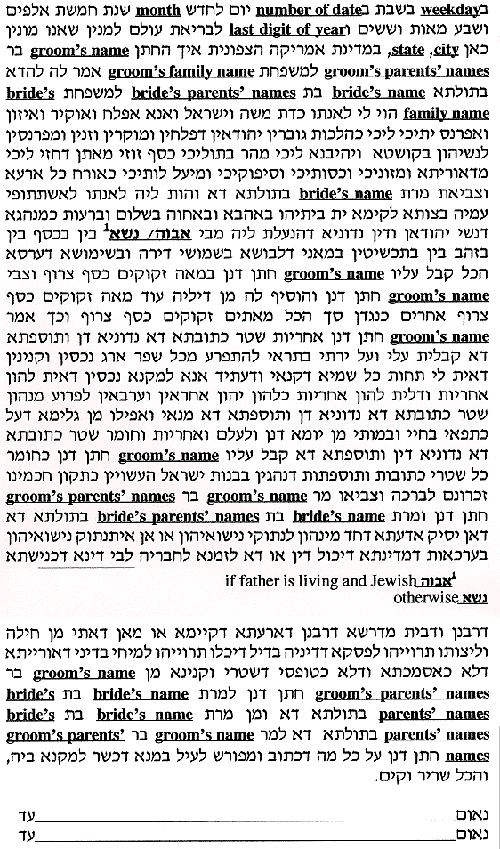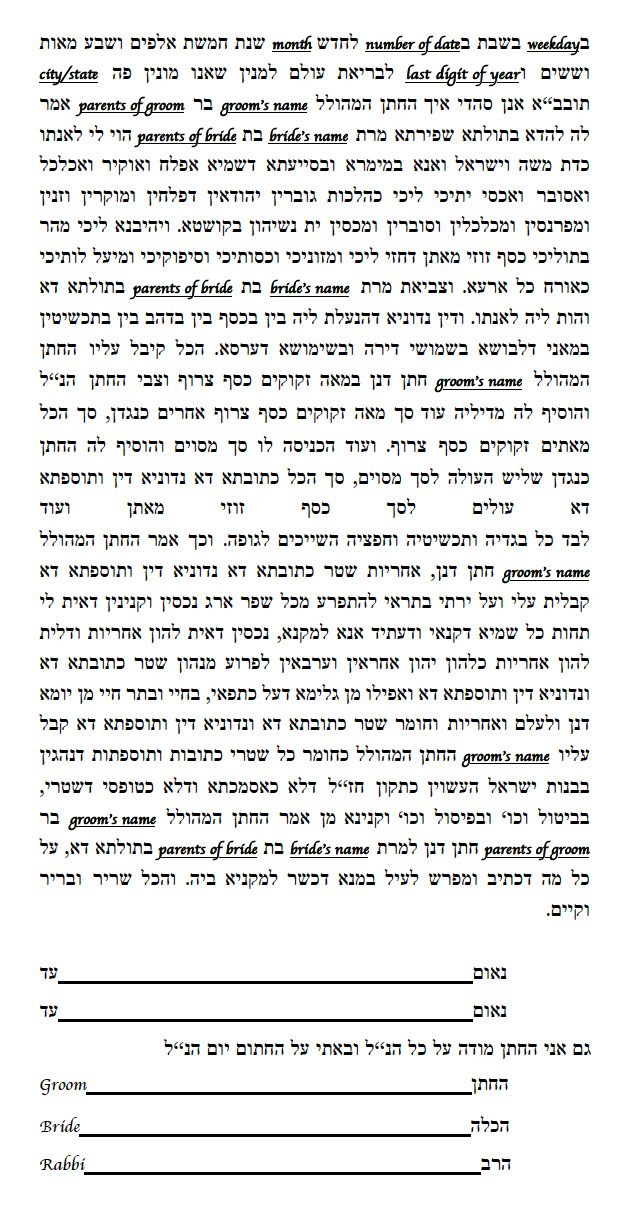This extensive collection of Ketubah texts draws upon tradition and renewal in Judaism. We will help you determine which ketubah text is right for you. Most texts below have some information attached, to help you understand their histories and deeper contexts. Any Hebrew/Aramaic text can be combined with any English text (and/or a text in any other language). We also encourage you to consider writing your own Ketubah text.
Choose from the following texts:
- Traditional Texts
- Traditional Egalitarian Texts
- Modern Texts
- Covenant Texts
- Interfaith Texts
- Same Gender Texts
- Secular Texts
Traditional Texts
Orthodox
The Traditional Orthodox ketubah text originates in Babylon and is written in Aramaic. Originally it incorporated individual stipulations but it became standardized about 200 B.C.E. During the Gaonic period (mid-seventh to eleventh centuries), the Babylonian academies struggled for hegemony over their Palestinian counterparts. One of the results was the eradication of the Palestinian ketubah and the establishment of the standardized Babylonian ketubah in the practices of Jewish communities. The Traditional Orthodox ketubah text creates a traditional, halachic Jewish marriage. The contract is not egalitarian. The ketubah text is both a record that the groom proposes marriage and the brides accepts his proposal as well as a document of the promises that the groom makes to the bride. Several legal responsibilities detailed in the talmudic tractates kiddushin and ketubot are assumed but not written in the text. Another subtext is that traditional Jewish marriage is based upon the quality of Hesed, sometimes translated as lovingkindness. Hesed means a total shift of one’s concern from oneself to the other, eliminating sef-centeredness and replacing it with a genuine concern and identification with the pain and problems of those around us. In marriage, concern becomes focused primarily upon one’s spouse and children.
The Orthodox text connects the marrying couple to God, Israel and Jewish history through the phrase that the groom says to the bride at the wedding: “Be mine in wifehood according to the laws and traditions of Moses and Israel”. Also, the groom’s monetary promises are from “the custom of Jewish men” that are “customary for daughters of Israel, according to the ordinances of our Sages, of blessed memory.” The concluding lines of this text refer to a kinyan that is made from the groom to the bride. Feminists claim that this refers to the acquisition of the bride by the groom. Rachel Adler writes: “kinyan [is] an act by which a subject unilaterally acquires specified rights over an object. Kinyan is essential in commercial transactions.” Traditionalists claim this is a misunderstanding of traditional Jewish marriage. As Moshe Meiselman explains, this contract is a “kinyan issur, a contract whose basic purpose is to effect a change in personal or ritual status furthermore, the word kinyan has been used metaphorically in biblical and rabbinic writings to indicate the establishment of a close and intimate relationship”. The Torah names the man as the initiator of the marriage contract. R. Shimon in the Talmud explains this choice: “it is the nature of a man to be active in the pursuit of a wife rather than for a woman to pursue a husband.”
In the same way, the man is the iniatiator of the divorce contract. The Orthodox text prepares the marrying couple for disasters by elaborating the monetary provisions that the groom has made for the bride in case of divorce and/or his death. These provisions are standard and stated in “zuzim”. The amounts are traditional/ historical and do not really signify divorce settlement– that is determined by state law. By elaborating these provisions, however, the marrying couple is reminded that marriage and divorce entail financial consequences. In order for the divorce to be complete, the man must send her a Get and she must willingly receive it. Without a Get, neither bride nor groom can remarry in a Jewish wedding. If she remarries without a Get, any children of this second marriage would be considered “mamzerim” or bastards, as they are children of an adulterous union. “Mamzerim” and all of their descendents cannot marry in a traditional Jewish wedding. The problem of a man refusing to give a woman a Get creates an “agunah”, literally a “chained woman” whose marriage has been terminated de facto but not de jure. In the Orthodox world, this problem has not been universally solved in a legal manner. Some Orthodox Rabbis require marrying couples to sign a prenuptial agreement referring to the Get. Others rely on social pressures to convince a man to grant a Get.
English:
On the day of the week, the day of the month of in the year 57 , according to the manner in which we count (dates) here in the community of , the bridegroom, , said to this virgin, : “Be my wife according to the laws and traditions of Moses and Israel. I will work, honor, feed, and support you in the custom of Jewish men, who work, honor, feed, and support their wives faithfully. I will give you the settlement (mohar) of virgins, two hundred silver zuzim, which is due you according to Torah law, as well as your food, clothing, necessities of life, and conjugal needs, according to the universal custom.” Miss agreed and became his wife. This dowry that she brought from her father’s house, whether in silver, gold, jewelry, clothing, home furnishings, or bedding, Mr. , our bridegroom, accepts as being worth one hundred silver pieces (zekukim).
Our bridegroom, Mr. agreed, and of his own accord, added an additional one hundred silver pieces (zekukim) paralleling the above. The entire amount is then two hundred silver pieces (zekukim).
Mr. , our bridegroom made this declaration: “The obligation of this marriage contract, this dowry, and this additional amount, I accept upon myself and my heirs after me. It can be paid from the entire best part of the properties and possessions that I own under all the heavens, whether I own (this property) already, or will own it in the future. (It includes) both mortgageable property and non-mortgageable preperty. All of it shall be mortgaged and bound as security to pay this marriage contract, this dowry, and this additional amount. (It can be taken) from me, even from the shirt on my back, during my lifetime, and after my lifetime, from this day and forever.”
The obligation of this marriage contract, this dowry, and this additional amount was accepted by Mr. , our bridegroom, according to all the strictest usage of all marriage contracts and additional amounts that are customary for daughters of Israel, according to the ordinances of our sages, of blessed memory. (It shall) not be a mere speculation or a sample document.
We have made a kinyan from Mr. , our bridegroom, to Miss , this virgin, regarding everything written and stated above, with an article that is fit for such a kinyan.
And everything is valid and confirmed.
Aramaic:
Conservative with Lieberman Clause
The Conservative ketubah text includes the complete Traditional Orthodox text. This text originates in Babylon and is written in Aramaic. Originally it incorporated individual stipulations but it became standardized about 200 B.C.E. During the Gaonic period (mid-seventh to eleventh centuries), the Babylonian academies struggled for hegemony over their Palestinian counterparts. One of the results was the eradication of the Palestinian ketubah and the establishment of the standardized Babylonian ketubah in the practices of Jewish communities.
The Conservative ketubah text creates a traditional, halachic Jewish marriage. The contract is not egalitarian. The ketubah text is both a record that the groom proposes marriage and the brides accepts his proposal as well as a document of the promises that the groom makes to the bride. Several legal responsibilities detailed in the talmudic tractates kiddushin and ketubot are assumed but not written in the text. Another subtext is that traditional Jewish marriage is based upon the quality of Hesed, sometimes translated as lovingkindness. Hesed means a total shift of one’s concern from oneself to the other, eliminating sef-centeredness and replacing it with a genuine concern and identification with the pain and problems of those around us. In marriage, concern becomes focused primarily upon one’s spouse and children.
The Conservative text connects the marrying couple to God, Israel and Jewish history through the phrase that the groom says to the bride at the wedding: “Be mine in wifehood according to the laws and traditions of Moses and Israel”. Also, the groom’s monetary promises are from “the custom of Jewish men” that are “customary for daughters of Israel, according to the ordinances of our Sages, of blessed memory.” Finally, when the bride agrees to become his wife, she agrees “to participate together with him in establishing their home in love, harmony, peace, and companionship, according to the practice of Jewish women. This last piece is an addition to the Orthodox text.
The concluding lines of the Conservative ketubah text state that a kinyan is made from the groom to the bride and from the bride to the groom. Both bride and groom are changing their personal status according to this text. This departs from the Orthodox text by creating a more bilateral contract. Feminists claim that kinyan refers to the acquisition of the bride by the groom (and, in this case, of the groom by the bride.) Rachel Adler writes: “kinyan [is] an act by which a subject unilaterally acquires specified rights over an object. Kinyan is essential in commercial transactions.” Traditionalists claim this is a misunderstanding of traditional Jewish marriage. As Moshe Meiselman explains, this contract is a “kinyan issur, a contract whose basic purpose is to effect a change in personal or ritual status furthermore, the word kinyan has been used metaphorically in biblical and rabbinic writings to indicate the establishment of a close and intimate relationship.”
Divorce can be initiated by both bride and groom according to the Conservative text. The text elaborates the monetary provisions that the groom has made for the bride in case of divorce and/or his death. These provisions are standard and stated in “zuzim”. The amounts are traditional/ historical and do not really signify divorce settlement– that is determined by state law. By elaborating these provisions, however, the marrying couple is reminded that marriage and divorce entail financial consequences. In order for the divorce to be complete, one partner must send a Get and the other must willingly receive it. The Conservative text utilizes the Lieberman Clause as an attempt to solve the “agunah” problem. This clause was added as an addendum to the ketubah text by the Conservative Movement of Judaism in 1953. Saul Lieberman, the premier expert in Conservative Jewish Law at the time, framed the Aramaic formula. The purpose of this clause is to prevent the problem of one partner refusing to offer/ receive a Get in case of civil divorce. The Bet Din of the Rabbinical Assembly and the Jewish Theological Seminary of America is granted the authority to fix and determine the amount of money to be paid by the party refusing to grant a Get. The dispute can then be taken to the civil courts. In order to make this clause legally binding, the bride and groom should both sign the ketubah or a similar letter of intent which the Rabbi keeps in his files and sends to the Rabbinical Assembly to be kept in their files. Finally, the Conservative movement has been using an antenuptial procedure since this was created by the Rabbinical Assembly in 1968. This states that if no Get is sent within six months of the marriage being sundered by the courts of the State, or within six months of one of them leaving their home with the intent of sundering the marriage, then this betrothal and marriage will be null and void from the start.
English:
We witness that on the day of the week, the day of the month of , in the year , corresponding to the day of , , here in , the groom, , son of , said to the bride, , daughter of :
“Be my wife according to the laws and traditions of Moses and the Jewish people. I will work on your behalf and honor, sustain, and support you according to the practice of Jewish men, who faithfully work on behalf of their wives and honor, sustain and suport them. I obligate myself to give you the sum of two hundred zuzim as the money for your ketubah, to which you are entitled according to Torah law. I will provide your food, clothing and necessities, and I will live with you in marital relations according to universal custom.
The bride, ________, agreed to these terms and to become his wife, to participate together with him in establishing their home in love, harmony, peace, and companionship, according to the practices of Jewish women.
The groom, _______, accepted responsibility for the full dowry that she brought from her _b_ house, whether in silver, gold, jewelry, clothes, or furnishings, amounting to the sum of one hundred zuzim and agreed to increase this amount from his own assets with the sum of one hundred zuzim, for a total of two hundred zuzim.
The groom, _______, said: “I take upon myself, and my heirs after me, the obligation of this ketubah, the dowry and the additional sum, to be paid from the best part of all my property, real and personal, that I now possess or may hereafter acquire. From this day forward, all my property, wherever it may be, even the mantle on my back, shall be mortgaged and liened for the payment of this ketubah, dowry, and additional sum, whther during my lifetime or thereafter.
___________, the groom, took upon himself all the obligations and strictures of this ketubah, this dowry, and this additional sum, as is customary with other ketubot made for Jewish women in accordance with the enactment of our sages, may their memory be for a blessing.
______, the groom and _____ the bride, further agreed that if one or the other should desire to dissolve this marriage, or if this marriage has been dissolved by the civil courts, then either of them shall have the power to summon the other to the Bet Din of the Rabbinical Assembly and of the Jewish Theological Seminary of America, or whoever shall be authorized by the same, and each will obey the binding decision of this court, in order that both of them may live in accordance with the laws of the Torah. This ketubah is not to be regarded as mere rhetoric or as a perfunctory legal form. We have performed the act which in Jewish law makes the obligations of this document legally binding on the part of ______, the groom, to _______, the bride, and on the part of ________, the bride, to _______, the groom, with an instrument fit for that purpose, in order to confirm all that is stated and specified above, which shall be valid and immediately effective.
b. “family’s” home if father is not living or not Jewish
Hebrew:









